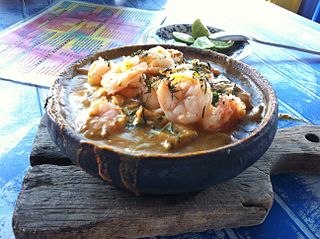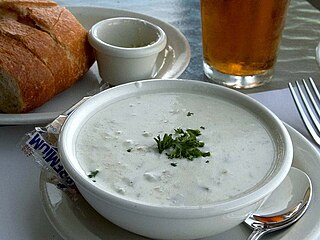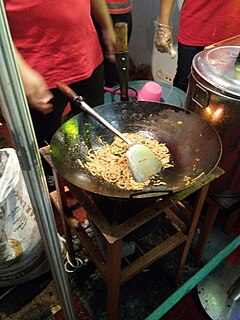De-Thuk is a Tibetan cuisine soup that includes yak or sheep soup stock along with rice, different types of Tibetan cheeses and droma, a type of Tibetan root. The rice is cooked with much water or stock to reach a consistency similar to Cantonese rice congee.

Chicken soup is a soup made from chicken, simmered in water, usually with various other ingredients. The classic chicken soup consists of a clear chicken broth, often with pieces of chicken or vegetables; common additions are pasta, noodles, dumplings, or grains such as rice and barley. Chicken soup has acquired the reputation of a folk remedy for colds and influenza, and in many countries is considered a comfort food.

Misosoup is a traditional Japanese soup consisting of a dashi stock into which softened miso paste is mixed. In addition, there are many optional ingredients that may be added depending on regional and seasonal recipes, and personal preference.

Hokkien mee is a Southeast Asian dish, popular in Indonesian, Malaysian, Singaporean and Thai cuisines, that has its origins in the cuisine of China's Fujian (Hokkien) province. There are three distinct types of Hokkien mee. The Singaporean variant consists of egg noodles and rice noodles stir-fried with egg, slices of pork, prawns and squid, and served and garnished with vegetables, small pieces of lard, sambal sauce and lime.

Momo is a type of East and South Asian steamed filled dumpling, popular across the Indian subcontinent and the Himalayan regions of East-South Asia border. Momos are native to Southwest Chinese region of Tibet,Nepal,Bhutan, North Indian region of Ladakh, Northeast Indian regions of Sikkim and Darjeeling.It is similar to Chinese baozi, jiaozi, and mantou, Mongolian buuz, Japanese gyoza, Korean mandu and Turkic manti. Momos are extremely popular among the natives of the Nepal,and can be found in every kind of shop from restaurants to street vendors.Also it has made great advance in Indian cities like Delhi,Mumbai after Nepalese and Tibetan people introduced it over there.

Banmian (板麵) is a popular Chinese noodle dish, consisting of handmade noodles served in soup. Other types of handmade noodles include youmian, or mee hoon kueh.

Noodle soup refers to a variety of soups with noodles and other ingredients served in a light broth. Noodle soup is common dish across East and Southeast Asia. Various types of noodles are used, such as rice noodles, wheat noodles and egg noodles.

Thukpa is a Tibetan noodle soup, which originated in the eastern part of Tibet. Amdo thukpa is a famous variant among Tibetan people and Himalayan people of Nepal. The dish is also consumed in the region of Sikkim, Darjeeling, Kalimpong and Arunachal Pradesh in India. It is also popular in the Ladakh region and the state of Himachal Pradesh. Thukpa is also eaten in Bhutan, where it is a type of porridge. There are numerous varieties of thukpa in Tibetan tradition, including:

Tibetan cuisine includes the culinary traditions and practices and its peoples. The cuisine reflects the Tibetan landscape of mountains and plateaus and includes influences from neighbours. It is known for its use of noodles, goat, yak, mutton, dumplings, cheese, butter, yoghurt and soups. Vegetarianism has been debated by religious practitioners since the 11th century, but is not prevalent due to the difficulty of growing vegetables, and cultural traditions promoting consumption of meat.

Soups in East Asian culture are eaten as one of the main dishes in a meal or in some cases served straight with little adornment, particular attention is paid to the soups' stocks. In the case of some soups, the stock ingredients become part of the soup. They are usually based solely on broths and lacking in dairy products such as milk or cream. If thickened, the thickening usually consists of refined starches from corn or sweet potatoes.

Cazuela is the common name given to a variety of dishes, especially from South America. It receives its name from the cazuela - traditionally, often shallow and of unglazed earthenware - in which it is cooked. The ingredients and preparation vary from region to region, but it is usually a mid-thick flavoured stock obtained from cooking several kinds of meats and vegetables mixed together.

Bhutanese cuisine employs much red rice, buckwheat, and increasingly maize. Buckwheat is eaten mainly in Bumthang, maize in the Eastern districts, and rice elsewhere. The diet in the hills also includes chicken, yak meat, dried beef, pork, pork fat, and lamb. Soups and stews of meat, rice, ferns, lentils, and dried vegetables, spiced with chili peppers and cheese, are a favorite meal during the cold seasons. Zow shungo is a rice dish mixed with leftover vegetables. Ema datshi is a spicy dish made with large, green chili peppers in a cheesy sauce, which might be called the national dish for its ubiquity and the pride that Bhutanese have for it. Other foods include jasha maru, phaksha paa, thukpa, bathup, and fried rice. Cheese made from cow's milk called datshi is never eaten raw, but used to make sauces. Zoedoe is another type of cheese made in the Eastern districts, which is added to soups. Zoedoe is normally greenish in color and has a strong smell. Other types of cheese include Western types like Cheddar and Gouda. Western cheese is made in the Swiss Cheese Factory in Bumthang or imported from India.

Fish soup is a food made by combining fish or seafood with vegetables and stock, juice, water, or another liquid. Hot soups are additionally characterized by boiling solid ingredients in liquids in a pot until the flavors are extracted, forming a broth.

Soup is a primarily liquid food, generally served warm or hot, that is made by combining ingredients of meat or vegetables with stock, or water. Hot soups are additionally characterized by boiling solid ingredients in liquids in a pot until the flavors are extracted, forming a broth. Soups are similar to stews, and in some cases there may not be a clear distinction between the two; however, soups generally have more liquid (broth) than stews.

Cheese soup is a type of soup prepared using cheese as a primary ingredient, along with milk, broth and/or stock to form its basis. Various additional ingredients are used in its preparation, and various types and styles of cheese soup exist. It is a part of some cuisines in the world, such as American, Colombian, Mexican, Swiss, French, and Tibetan cuisines. Mass-produced cheese soups may be prepared with the addition of food additives to preserve them and enhance flavor. A list of cheese soups is included in this article.
Tsam-thuk is a type of Tibetan cuisine soup that uses yak or sheep soup stock and tsampa as well as a variety of Tibetan cheeses. It can be served at room temperature.

Lettuce soup is a soup prepared with lettuce as a primary ingredient. It may be prepared with myriad lettuces and other ingredients, and some lettuce soups may use several cultivars of lettuce in their preparation. It is a part of French cuisine and Chinese cuisine. Cream of lettuce soup is a type of lettuce soup prepared using milk or cream. The soup may be served with toast or rolls as a side dish or with the soup atop them. It may be served as an appetizer, a side dish or as a main dish, and may be served hot or cold.

Indonesian noodles are a significant aspect of Indonesian cuisine which is very diverse. Indonesian cuisine recognised many types of noodles, with each regions often developed their distinct recipes.
| This soup-related article is a stub. You can help Wikipedia by expanding it. |